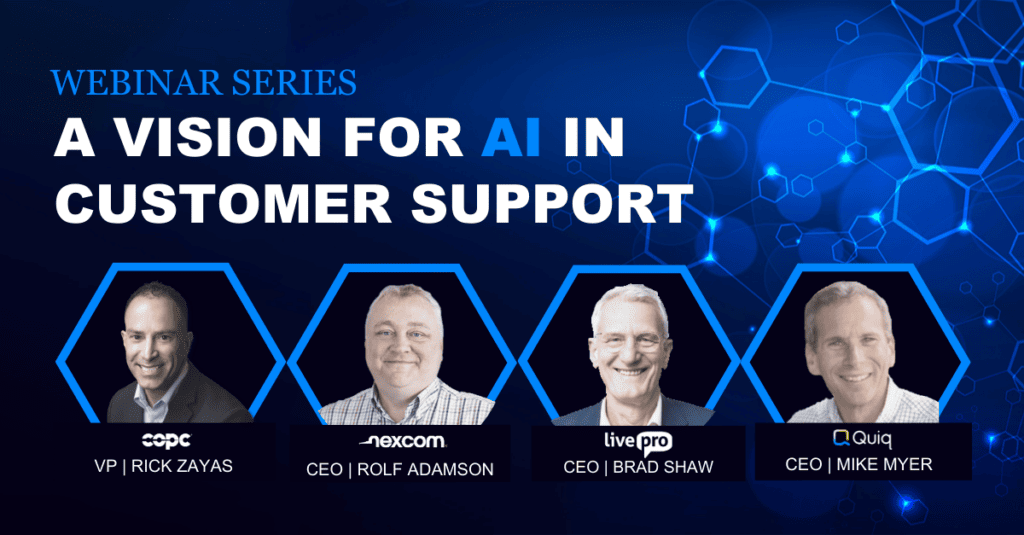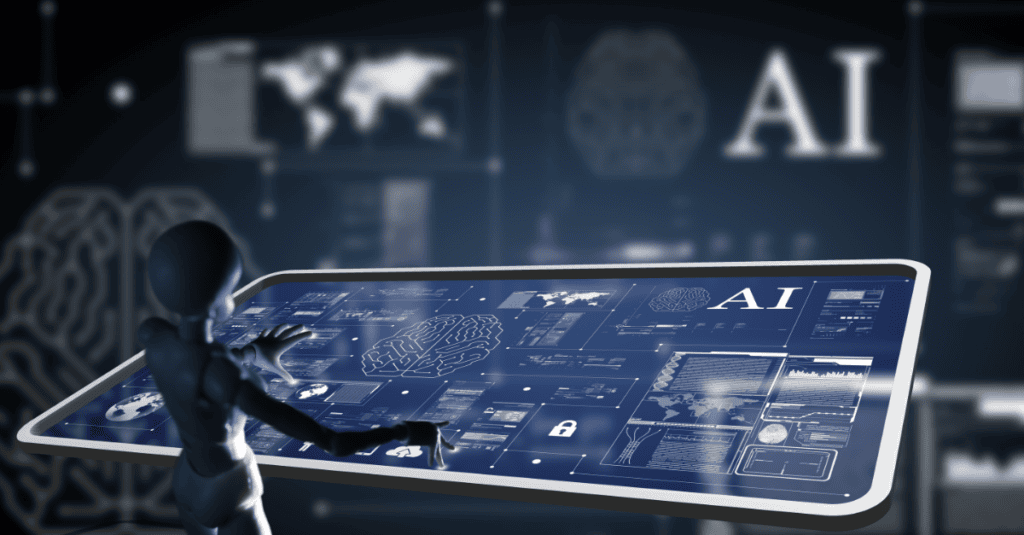
April 2, 2024
Customer experience technology is advancing exponentially through the power of AI. This article explores the inner workings of AI assistants, showcasing their ability to provide direct answers to customer inquiries.
We begin by laying the groundwork with a comprehensive review of AI terminologies. Then, we look at the critical aspects of knowledge content and protective measures. Finally, we delve into the roles, processes and timelines of creating a customer-facing AI assistant.
Understanding AI Terminology
Generative AI: These are algorithms trained to predict data sequences based on training information. Two of the most common sequences they generate are text and images.
Large Language Models (LLMs): LLMs are a subset of generative AI focused on text and image generation. LLMs are unique because they have been trained on enormous data sets. This training gives them capabilities beyond any AI we have seen before. Examples include ChatGPT from Open AI, Bard from Google, and Llama from Meta.

The Magic of LLMs
LLMs excel in two skills: reading and writing language and answering questions from the information used to train them. They achieve this by training in vast amounts of data and iterative fine-tuning. The AI learns language nuances and patterns to predict words and generate meaningful responses. .
The fine-tuning process involves human interaction. Experts interact with the AI, scoring its responses and providing corrective feedback. This human-AI synergy refines the model’s ability to provide accurate answers.
While LLMs exhibit what appears to be knowledge, they lack genuine comprehension. They respond based on their training and feedback loop, blurring the lines between knowledge and understanding.

Related
CX Technology Consulting
Fusing technology and expertise to design and deliver exceptional service journeys.
Ensuring Accuracy and Safety
By now, everyone reading this article has likely used ChatGPT. ChatGPT’s ability to understand questions and generate well-written responses is impressive. However, because of the recency of the training data, you have probably also encountered incorrect answers and limitations.
There are two overarching concerns in AI-powered customer support: accuracy and safety. Quiq is an industry leader in LLM-powered conversational AI. The company utilizes the LLM’s skills to read and write language while disabling the LLM’s ability to answer questions based on its training data.
We refer to this as giving the LLM amnesia, just like a person with amnesia who can communicate with language but can’t remember anything. Think of “amnesia” as a protective mechanism. The AI uses only the company’s information rather than relying on its extensive training data. The vast training information isn’t useful for answering questions like “Where is my order?”
We need to insert our own information and make the LLM forget all it knew before. This methodology empowers businesses to provide secure, accurate, and brand-specific responses without hallucinations (answers made up by the LLM that are not factual).
Just as important as answering questions with the correct information (accuracy) is that the AI doesn’t say something embarrassing (safety). For instance, we would want the AI to carefully answer questions like “What are the limitations of your products?” or “How does your product compare with a competitor X?” Another aspect of brand safety is answering questions in the tone and voice of the brand.
While this all sounds daunting, don’t let it diminish your enthusiasm for what the latest AI can accomplish. With the right AI platform and expert partner, you can harness the power of the LLM to provide accurate and safe answers to customers.
Crafting LLM AI Assistants: Roles, Process and Timelines
Using the latest AI may seem as easy as developers using APIs in commercial LLM options like OpenAI. But it’s much more than enlisting engineers to call LLM APIs. It takes a diverse team to build and deploy an effective AI assistant to answer customer’s questions.
Developing an LLM AI assistant involves multiple ingredients.
Team: Beyond engineers, various roles contribute to the AI assistant’s creation. Development requires conversational designers, UX engineers or product managers to:
- Map the customer journey and identify the types of questions customers are asking
- Determine how to answer those questions
- Identify where the required data lives
It is essential to know how well AI is doing and where it can be improved. Understanding performance requires data analysis by business/data analysts or data scientists.
Design: Crafting a user-friendly conversation design starts with mapping the customer journey to solutions. LLM interactions differ from prior generations of chatbots, which required scripted interactions. The LLM is skilled in language, so the conversation design emphasizes instructing the LLM rather than scripting each utterance.
Process: Building an AI assistant follows defined steps, with the design and experience creation phases being the most critical.
All AI assistants follow a similar pattern to answer customer’s questions:
Customer Query: The process starts with the customer asking a question.
Decomposition: The AI divides the question into various characteristics, creating features to find later information. For instance, if an AI assistant were answering questions about car insurance, details like the customer’s location, policy status, prospect or current customer would be helpful in addition to the intent behind the query (e.g., claims or policy purchase).

Iterative Classification: Once you identify some characteristics, it may be helpful to tease out additional elements based on what you know.
Using our car insurance example, if the customer is asking about claims, we may want to determine whether the inquiry is about a new or existing claim. Determining the information hierarchy we want the LLM to collect is part of the journey-mapping design process.
Information Retrieval: After obtaining all of the necessary characteristics, we use the company’s information to get the answers to the customer’s question. This information can include static knowledge and data, often obtained through knowledge bases and APIs. Note that AI doesn’t gather the information for the answer, eliminating the risk of inaccuracies.
Language Generation: The AI assistant employs the LLM’s language generation capabilities to create a tailored response for the specific question as opposed to simply returning some standard, static text.
Fact-Checking and Safeguards: We apply fact-checking and safeguards to ensure accuracy and brand safety. This step verifies that the LLM’s response is accurate and appropriate for the given question and uses only the company’s information in the response.
By following these steps, the AI assistant can deliver responses that are accurate and highly personalized to the customer’s query. This approach leverages the amazing capabilities of LLMs for powering customer experience technology while mitigating potential risks.
Timeframes and Realities

One of the most appealing aspects of creating an AI assistant is the relatively swift timeline. The processes have sped up because using LLMs eliminates much of the laborious training necessary in prior generations of AI.
It takes about a month to finish crafting an AI assistant, including design, review and inevitable human-centric delays. Complex user journeys with user-specific internal data only extend the timeline by one to two months.
Contrary to perceptions of lengthy projects, building an AI assistant is a streamlined journey, thanks to the leverage of LLM for language generation and comprehension.
A Gateway to CX Transformation
As we navigate this path of AI assistant creation, it’s evident that roles extend beyond engineers. Timelines are also far more reasonable than one might expect. A fusion of creativity, strategy and technology marks the process itself.
The Role of Quiq: Navigating the AI Landscape
As the AI landscape evolves, Quiq emerges as a key player in harnessing AI for enhanced customer interactions.
Quiq’s expertise lies in merging asynchronous messaging with advanced AI capabilities, offering businesses a comprehensive platform. Quiq is pioneering the next generation of customer experience with generative AI.
The future of customer interactions is at the intersection of technology and human expertise. With Quiq, businesses can embrace AI’s potential while ensuring that the essence of human connection remains intact.
The Role of COPC: Partnering for Success
A blend of vision, knowledge, meticulous design, and near-flawless execution is paramount to excelling in customer experience.
COPC partners with leading global brands, guiding them in crafting and implementing their CX strategies. This is achieved by empowering and inspiring teams, instituting sound processes grounded in best practices, and employing cutting-edge technology.
COPC offers an array of assessment, transformation, and enablement services to address any CX technology challenge. By leveraging a fusion of technology and expertise, COPC empowers organizations to design and deliver exceptional service journeys.

Webinar Series
A Vision for AI in Customer Support
This webinar series explores the potential of AI to revolutionize both front-end processes that impact customer interactions and back-end operations.
Conclusion
The evolution of AI assistants is an exciting chapter in the realm of customer experience. With Quiq as your partner and COPC as your guide, you can explore this next generation of AI with confidence, purpose, and a clear roadmap.
By leveraging LLMs for language generation and understanding, the focus shifts from creating training data to crafting the customer experience. Using Quiq, businesses can embrace AI’s potential while ensuring that the essence of human connection remains intact.
Maintaining brand tone and safety is a delicate balance between AI capabilities and human guidance. Instructions provided to the AI, fact-checking and safeguards ensure that the AI responses are consistent, appropriate and aligned with the brand’s identity.
Mastering AI integration into customer experience requires the right team of customer experience, operational and technology experts. COPC consultants, working closely with leading technology solution providers, will help you successfully navigate the intersection of AI, technology and human interaction.
As businesses continue embracing AI, the convergence of human expertise and AI capabilities promises a dynamic future for customer interactions. While AI enhances efficiency, the human element remains vital for building connections. The path forward lies in striking a harmonious balance between automated AI interactions and personalized human engagement.

Rick Zayas
Vice President, CX Strategy & Performance Improvement at
COPC Inc.
Great brands surpass their competitors through superior CX. However, delivering this level of service can sometimes be more complex than it sounds. As CX consultants, our expertise is helping organizations through CX industry changes to resolve their most critical issues and tackle everyday challenges. Learn more about how COPC can help your organization excel.

